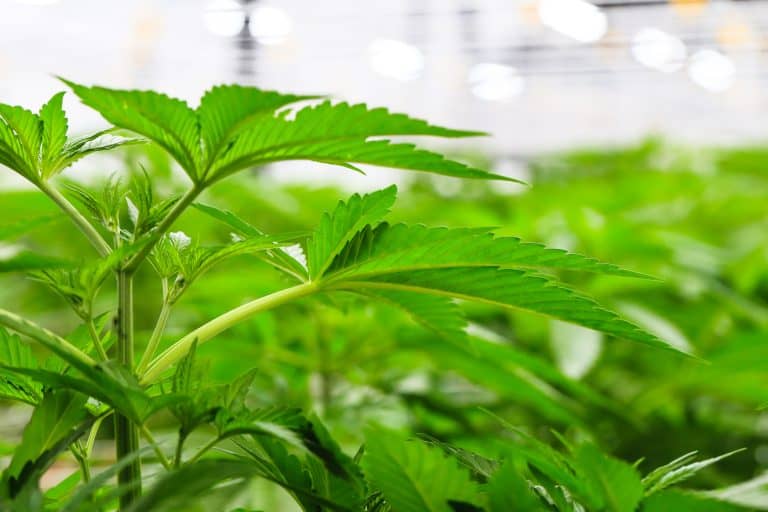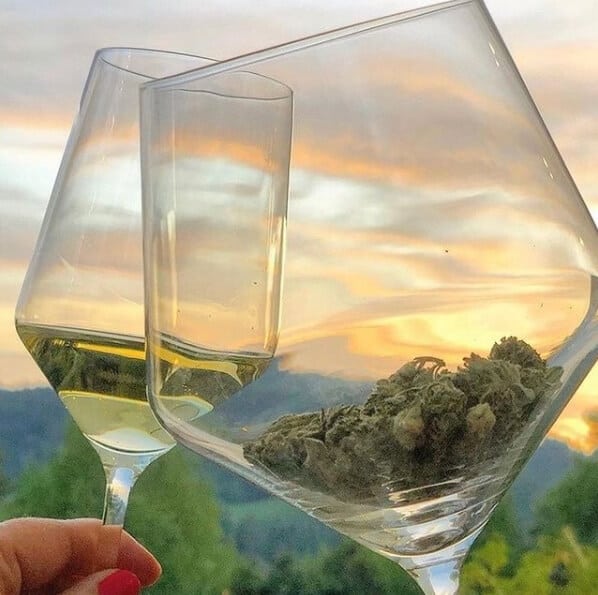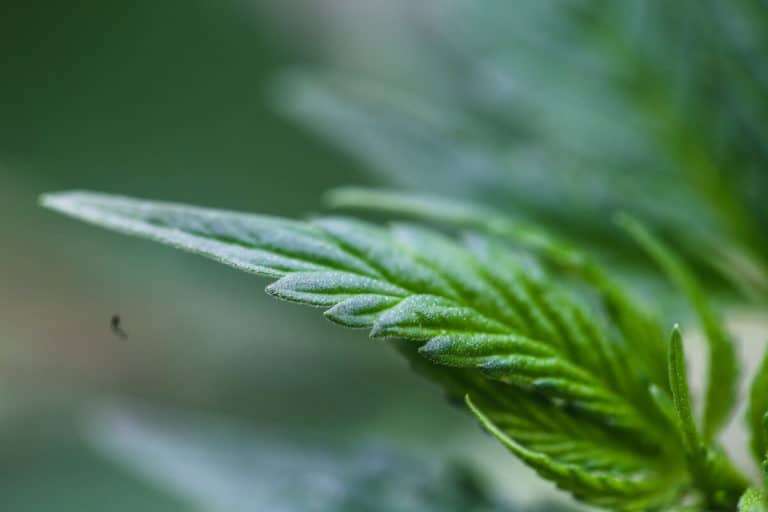Indoor vs. high quality outdoor weed: A visual guide
This guide was created to help sift through the endless varieties of cannabis we now have available to us at dispensaries. Now, this doesn’t apply to all strains, because every strain has different characteristics and grows different with every farmer’s care. However, these tools can be used to help analyse the often subtle differences between cannabis cultivated outdoor or indoor. At the end of the day, cannabis is a diverse and incommensurable plant — not all distinguishing factors will apply to every situation because every strain is unique.
It’s important to note that buds can be grown properly or improperly regardless of whether they were grown inside or outside, so improperly grown indoor can visually look like outdoor, while properly grown outdoor can easily look like indoor. But there are some standard tell-tale signs that cannabis has been grown inside or outside, so sit back and enjoy our visual guide to indoor vs. outdoor marijuana.
First let’s get a base calibration to see where you are starting.
Can you differentiate which one was cultivated indoors and which was cultivated outdoors?
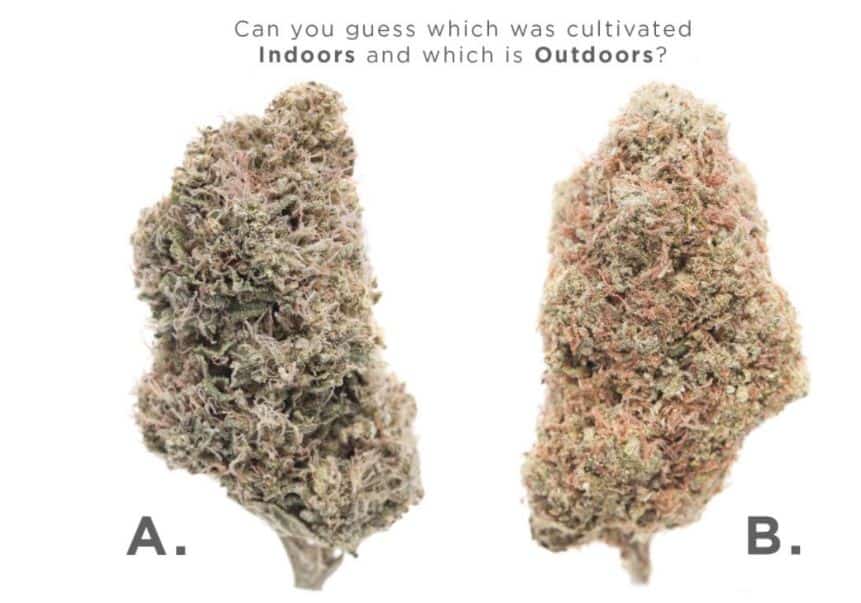
Size
The sizes of the buds are, in many ways, the first visual cues to tell whether buds were grown indoor or outdoor. But it is a general rule of thumb that everything is bigger with outdoor-cultivated buds. The buds themselves are bigger and chunkier, but one of the most foolproof ways to differentiate the two is by looking at the stem. Outdoor grown buds will have a significantly thicker stem than indoor cultivated nugs. Indoor buds will typically be smaller and more dense than outdoor’s big, clunky nugs.
Trichome Density
Trichome density is a key visual cue when attempting to differentiate between indoor cultivation and outdoor cultivation. Because indoor buds are smaller, closer to their light source, and in a perfectly controlled environment, they typically rank very high on the trichome density scale. So when examining an impeccably grown indoor nug all that can be seen is glimmering crystals with very little plant material visible. Outdoor nugs on the other hand are generally larger, so those trichomes would have to work much harder to cover the entire surface of an outdoor bud. Additionally, outdoor plants are subjected to the elements which can damage trichome development. So the trichome density is typically more sparse on outdoor-cultivated nugs than ones grown indoors.
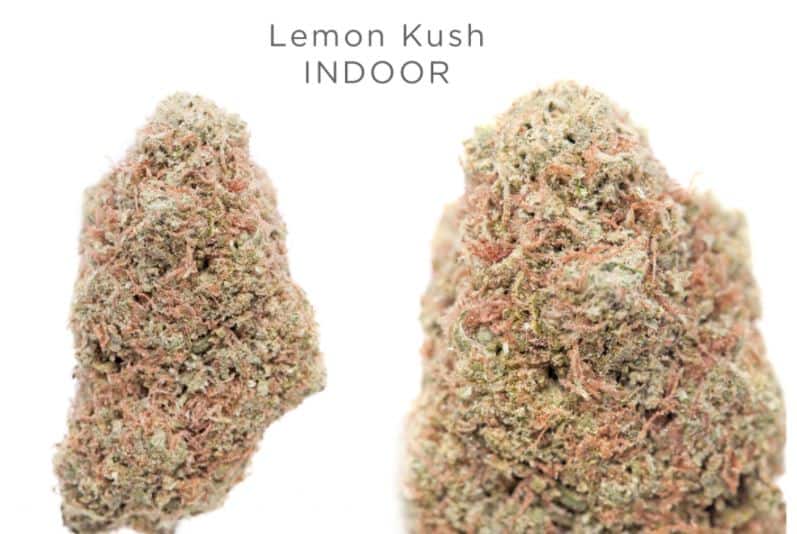
Color
One of the most significant visual characteristics that can be used to differentiate sun-grown cannabis versus indoor-grown cannabis is the color. Outdoor cannabis tends to have a darker hue in general. If the cultivar produces green flowers, outdoor nugs will appear a darker green, possibly leaning towards brown if not cured correctly, while indoor buds will be a brighter, more vivid green. If the cultivar produces purple flowers, high quality outdoor weed will turn a deep, striking purple while indoor nugs will stay lighter shades of purple (unless the strain’s genetics produce dark purple buds in any condition).
Another visual cue is the color on the bottom of the flowers. Buds cultivated outdoors almost always have a light brown color surrounding the stalk at the base of the bud (don’t worry it’s not mold). Usually, the tiny bracts at the bottom of the stalk will be a light brown as well. Indoor buds, on the other hand, are bright green (or purple) throughout.
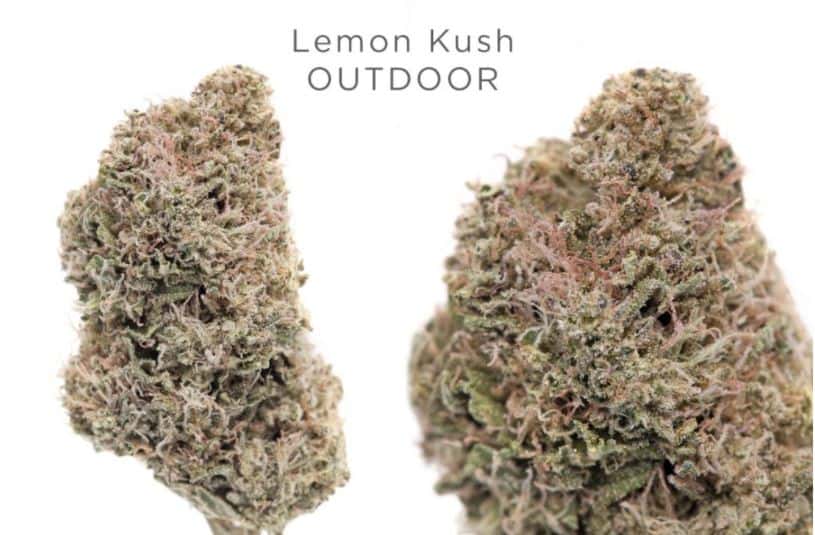
Cannabinoids
There is a widespread myth that high quality outdoor weed is less potent than indoor-cultivated cannabis. Simply put, that’s just not true. The dedicated farmers at Sunna Ra Acres have busted this myth once and for all. For the last few years, they have been conducting side-by-side tests of two clones taken from the same mother plant, one grown outdoors and one grown indoors. They’ve executed this experiment with a variety of strains and each time, the plant that is cultivated outside under the sun results in a higher overall cannabinoid profile. That means higher in THC, higher in CBD, higher in THCv, etc. Their experiment has shown that the sun unleashes the plant’s true potential and heightens its medicinal power.
Terpenes
In this case, terpenes are very similar to cannabinoids in that their profiles are intensified by the sun. In Sunna Ra Acre’s many years of experimentation they have found that if two identical plants are grown “side-by-side” — one grown outside, one grown inside — the plant that is grown outside will have a higher percentage of terpenes. And in some cases, the plants even reveal terpenes no one knew were there. When these two plants are smoked, the difference is very distinguishable with the outdoor being much more flavorful and aromatic. With that said, terpenes are volatile, meaning they will evaporate without proper drying and curing processes. Many indoor growers take greater care in their final stages of drying and curing because they yield far less and their product moves from one indoor room to another, providing more control through the process. New outdoor growers versus seasoned outdoor growers may overlook the step of proper drying and lose their high-terpene profile as a result.
Trim Job
While this category is very subjective and does not always apply, historically, outdoor growers spend less time trimming their final product than indoor growers. This typically has to do with the amount of bud harvested, outdoor growers are pulling down 5, 10, or 20 lbs per plant while indoor growers are pulling down 0.5, 1, or 2 lbs per plant. Trimming mass amounts of weed per plant would not only take weeks, but a big full-time crew would be needed. So the end result is usually a looser, leafier trim job — especially because outdoor plants are leafier in general. So while not always applicable, you can typically spot the difference between outdoor and indoor pretty immediately by scoping out the trim job.
Running through all these characteristics, with some give and take, while analyzing the hundreds of buds available for purchase at your local dispensary will help you to differentiate the outdoor grown from the indoor grown. If you are lucky enough to have access to the same flower cultivated both indoors and outdoors, it is amazing to smoke them side-by-side and compare the flavor profiles versus bag appeal. Indoor typically has better bag appeal while outdoor has the better flavor profile — it’s all about what you’re looking for in your daily smoke.
Before we go, there is a huge elephant in the room that we have not discussed today and that is greenhouse cultivated cannabis. Greenhouses are can be categorized as indoor cultivation using the power of the sun. It is the perfect marriage of indoor and outdoor because you have the environmental control of indoor but the incredible power of the sun. The result is typically buds that have the bag appeal of indoor with the elevated terpene and cannabinoid profiles of outdoor.
FAQs
Can You Smoke Brown Weed?
Yes, you can, but it’s not going to be as potent or flavorful. The three things that degrade cannabis are heat, light, and time. When brown in color, weed has lost some of its potency and therapeutic value as the cannabinoids, such as THC, have been degraded. In addition, it’s lost a lot of its smell and flavor as the terpenes have potentially oxidized or evaporated. Smoking brown weed will not severely injure you or make you sick, but it is not suggested for use.
Ultraviolet (UV) rays from the sun do break down your cannabis over time. An oft-referred to study from 1976 at the University of London said light is the No. 1 reason for cannabinoid breakdown. If it’s burnt or overexposed to the sun during the growing process, weed will appear brown in hue. The color is due to sun damage on the colas of the plant, and it’s been shown cannabidiolic acid (CBDA) can transform into cannabidiol (CBD) with enough exposure, and THCV will degrade into CBV. In that case, some THC could still be intact, but the cannabinoids were at least partially transformed, or decarboxylated out of the plant by the sun.
How Much of a Difference in Quality is high quality outdoor weed vs. Indoor Weed?
There is high-quality weed both grown indoors and outdoors, but there are certain factors that determine the quality of the end product.
Between indoor and high quality outdoor weed cultivation, the distinguishing factor in quality is the control of its environment. Factors such as temperature, light, water, humidity, carbon dioxide (CO2) exposure and care are going to be easier to control during indoor cultivation. While some strains may appear to grow a bit wilder outdoors, they are capable of developing the same amount of cannabinoids and terpenes as indoor-grown cannabis. Because of the unpredictability of nature, outdoor growing often requires a tepid climate.
The biggest case for growing weed outdoors is energy efficiency. Using all sunlight, or even just partial use of sunlight, to grow cannabis can save home growers and large-scale producers a lot of money in energy consumption. To take advantage of daylight and to take into account its variation during the year, many facilities have adopted a supplemental light grow in states where regulations permit it. Supplement light means the growers are using the sun when they can and then use lights when sunlight is unavailable, if the weed needs it.
The quality is mainly dependent on the seeds, the grower’s experience, and the care, not whether it was grown indoors or outdoors. Outdoor cultivation has a long history in Northern California; the Emerald Triangle of Humboldt, Mendocino, and Trinity counties got its name because of its ideal climate for outdoor cultivation. In a handful of legal cannabis states, regulations may require grows to be indoors and hidden from public view.
Written by: Weedmaps.com




